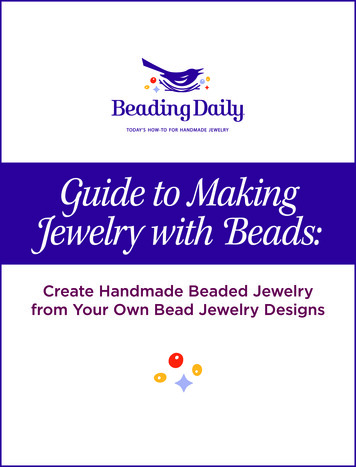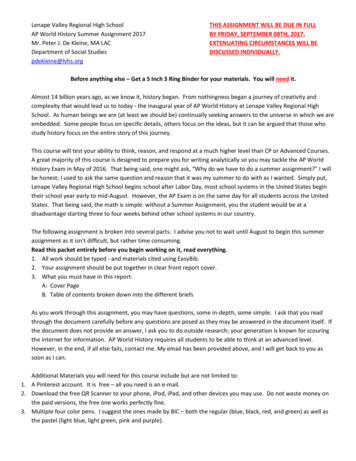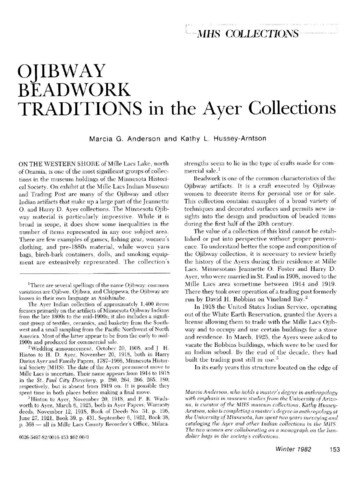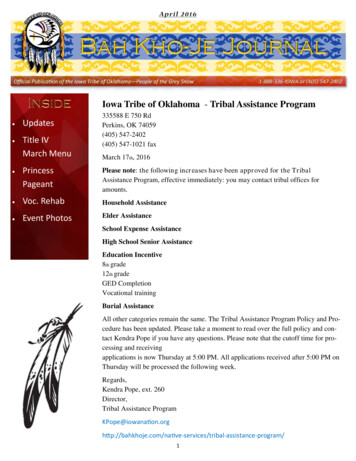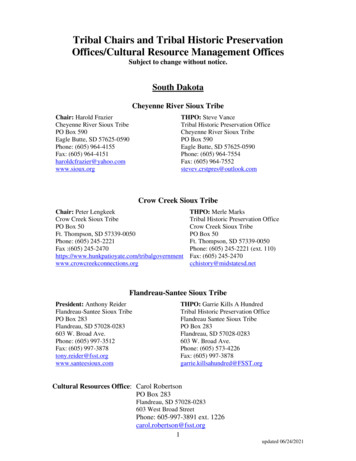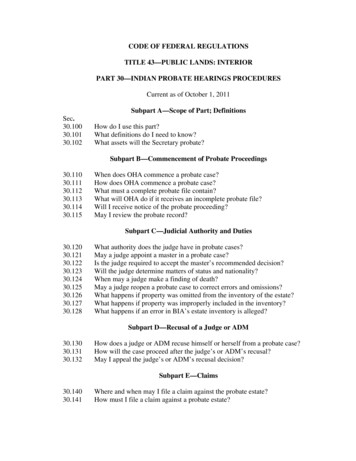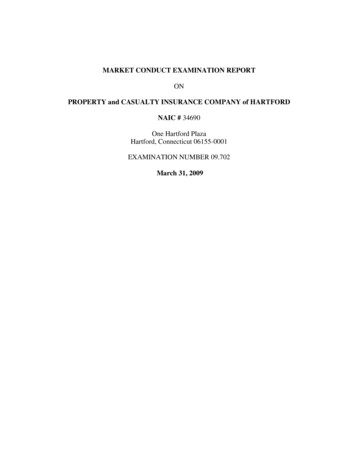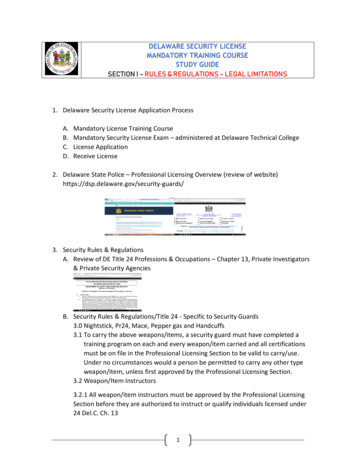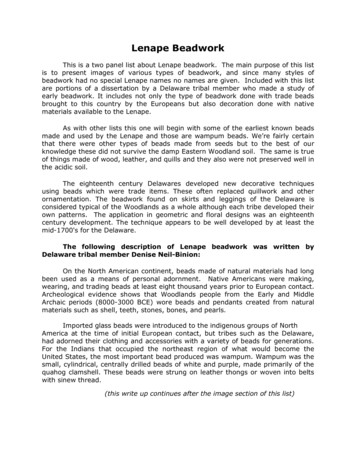
Transcription
Lenape BeadworkThis is a two panel list about Lenape beadwork. The main purpose of this listis to present images of various types of beadwork, and since many styles ofbeadwork had no special Lenape names no names are given. Included with this listare portions of a dissertation by a Delaware tribal member who made a study ofearly beadwork. It includes not only the type of beadwork done with trade beadsbrought to this country by the Europeans but also decoration done with nativematerials available to the Lenape.As with other lists this one will begin with some of the earliest known beadsmade and used by the Lenape and those are wampum beads. We’re fairly certainthat there were other types of beads made from seeds but to the best of ourknowledge these did not survive the damp Eastern Woodland soil. The same is trueof things made of wood, leather, and quills and they also were not preserved well inthe acidic soil.The eighteenth century Delawares developed new decorative techniquesusing beads which were trade items. These often replaced quillwork and otherornamentation. The beadwork found on skirts and leggings of the Delaware isconsidered typical of the Woodlands as a whole although each tribe developed theirown patterns. The application in geometric and floral designs was an eighteenthcentury development. The technique appears to be well developed by at least themid-1700's for the Delaware.The following description of Lenape beadwork was written byDelaware tribal member Denise Neil-Binion:On the North American continent, beads made of natural materials had longbeen used as a means of personal adornment. Native Americans were making,wearing, and trading beads at least eight thousand years prior to European contact.Archeological evidence shows that Woodlands people from the Early and MiddleArchaic periods (8000-3000 BCE) wore beads and pendants created from naturalmaterials such as shell, teeth, stones, bones, and pearls.Imported glass beads were introduced to the indigenous groups of NorthAmerica at the time of initial European contact, but tribes such as the Delaware,had adorned their clothing and accessories with a variety of beads for generations.For the Indians that occupied the northeast region of what would become theUnited States, the most important bead produced was wampum. Wampum was thesmall, cylindrical, centrally drilled beads of white and purple, made primarily of thequahog clamshell. These beads were strung on leather thongs or woven into beltswith sinew thread.(this write up continues after the image section of this list)
Wampum beadsPre-contact Wampum BeadsThese pre-contact wampum beads areabout 0.3 inches long, or 0.7 cm.This is from a string of mixed types ofwampum beads.
Wampum Bead NecklaceThese small wampum beads are eachabout 0.3 inches long, or 0.8 cm.
Depicted are Lenape man and woman with amale child in the attire typically worn by theDelaware tribe. All three are wearingornaments of various kinds, including jewelry,headbands, belts and feathers. The adultsare carrying long pipes, and both males carrybows and, in the case of the man, a quiver fullof arrows. They are all barefoot.The description of the clothing in the articlewith the drawing describes the man aswearing a breechcloth but the artistmistakenly drew it in the form of skirt.Beads were sometimes made fromother types of shells like the smallshells used in the earrings worn byJacques, a Munsee Delaware, drawnin Holland in 1645.
Wampum Treaty BeltThis was one of the belts the Lenapegave to William Penn about 1683.Wampum Belt for wearingNora Thompson DeanWampum Beads on Deerskin DressMary Louise Watters
Beadwork on clothesBeaded BreechclothNMAI 2/6529, undatedThis breechcloth is decorated withbeadwork and also with ribbonworkdown the edges.Beadwork on Woman’s Wrap-aroundSkirtThis beadwork design was appliquédon to a woman’s skirt. The samedesign was repeated multiple timesaround the bottom of the skirt.
Beadwork on Woman’s Wrap-aroundSkirtThis beadwork design was appliquédon to a woman’s skirt. The samedesign was repeated multiple timesaround the bottom of the skirt.Man’s Beaded Hunting CoatThis hunting coat was decorated withbeadwork and was made about 1850.
Beadwork on a man’s deerskin coat,about 1850.Another man’s deerskin hunting coatelaborately decorated with beadwork.Man’s Beaded Vest
Beadwork on Woman’s LeggingThiswoman’sclothleggingisdecorated with beadwork with littlediamond design similar to what wouldhave been done in ribbonwork. It wasmore common to decorate theleggings with ribbonwork. This wasmade about 1970.Beadwork on man’s leggingsThese are Delaware man’s leggingsdecorated with beadwork in floral orleaf designs.
Early examplemoccasin cuffs.ofbeadworkonThese early Delaware moccasins aredecorated with small white beads.Delaware moccasins made about1930. The toe is decorated withbeadwork and the cuffs have abeaded edge around them. The cuffsare also decorated with ribbonwork.MoccasinsThese moccasins were made for aDelaware man and have beadwork onthe toe as well as around the edge ofthe cuffs. The cuffs are also decoratedwith ribbonwork. Made about 2018.
Moccasins with beadwork on the cuffs.They were made by Lillie Davis.Beaded AccessoriesBias weave beadworkBias weave beadworkNora Dean about 1974
Lucy Parks Blalockbeaded strip.displaysaOn a trip east we stopped at theState Museum of Pennsylvania inHarrisburg. Lucy was taken to thestacks and shown some Delawarethings. One thing they said was“Here is a beadwork strip made byLucy Parks.” Lucy was shockedand said, “That's me!” She saidshe probably made it in her teens.These are split necklaces done on aloom.Nora and Louise Dean about 1983.
Small beaded bag made ofdeerskin and decorated with floralbeadwork.Rope-style net beadwork choker
Net beadwork made as a choker.made about 1965Beaded pouch on woolen stroudcloth with calico liningdated 1832. about 8 inches tallNMAI 24/4153
Beaded Sashloom beadwork done on yarn warp.Nora and Louise Dean 1975Beaded deerskin bag withwampum bead fringemade by Nora Thompson Deanin 1970’s
Bandoleer Bagmade by Delaware artist Joe Bakerin 2012Tulip Pursemade by Pom-mah-pun-aquaabout 1920Beadwork on the panels and largebeads on the fringes of this pursefor the women.Lenape Beadwork article, continued:Wampum, is not mentioned again until the seventeenth century whencolonizers such as the Dutch lawyer and commentator Adriaen van der Donckdescribed the production of wampum.“They strike off the thin parts of those shells and preserve the pillarsor standards, which they grind smooth and even and reduce the sameaccording to their thickness, and drill a hole through every piece and
string the same on strings” (figure 4). Van der Donck also wrote thatwampum was strung and worn around the neck, wrists, and head, aswell as using it to decorate clothing. He specifically noted that thelower borders of women’s skirts were tastefully decorated withwampum. In the 1650s, Peter Lindström recorded that DelawareValley Indians greased their hair with bear fat so that, “it shines sothat one can see one’s reflection in it.” Then “the locks they bind upwith braids and ribbons . On the ends of their hair they string money(wampum) and tie a knot to (it).”It was the fur trade that led to the wide spread use of European trade goodsand the eventual predominance of using glass beads as a method of decorativeembellishment among Native Americans. As early as 1675, traders began toexchange glass beads for animal pelts. These beads were commonly referred to aspony beads, possibly because they were transported by trader’s horses. Theprocess of manufacturing glass beads had been further refined making it possible toproduce beads two millimeters and smaller in diameter. Because of their small sizethese beads were commonly referred to as seed beads, and when they becameavailable in quantity, the adornment of clothing and other objects created by NativeAmericans underwent significant change.First used for stringing necklaces, glass beads were most widely availableblack, white, and blue. Before Native American beadworkers used seed beadscreate elaborately beaded bags, they used limited amounts of pony beadscombination with quillwork. An interesting example of this can be seen inDelaware shoulder bag from the late eighteenth century.intoinaIn this bag, the artist created geometric designs in quillwork on a hide pouch,but the strap is embellished with pony beads. The bag is also decorated with reddyed hair inserted into metal cones. The use of metal cones was also important.Not only were movement and sound important to Native Americans, the reflectivityof metallic objects was associated with the brightness of the color white and itsrelationship to spiritual well-being. Interestingly, the use of red-dyed hair (and laterred yarn) and metal cones remained a decorative embellishment on many Delawarebandolier bags throughout the nineteenth century.
As seed beads became more available, beadworkers took advantage of theiraesthetic properties using them exclusively as their decorative material of choice.Delaware beadwork of the early nineteenth century used floral motifs as well asother design elements, but the quantity of beads, abstract designs, and vibrantcolor palette used in the Prairie style were not yet developed. The transition to theuse of seed beads and the incorporation of floral designs can be seen in an exampleof an early nineteenth-century coat created by a Delaware or Shawnee beadworker.The artist embroidered floral designs onto a hide coat accented with fringe. Thecuffs, hemline, waistline, and collar of the coat are decorated with simple, repeatingfloral patterns in blue, light blue, yellow, red, green, and black beads with somedesigns outlined with a row of white beads. The restrained design is an excellentexample of early use of seed beads.In another example of a beaded coat dated to 1840-1860, the beadworkerhas again limited the number of beads used to decorate the coat; Abstract floralmotifs in blue, light blue, pink, and burgundy are repeated around the bottom edgeof the coat; these designs are no longer open curvilinear forms, but instead theyare fully formed floral designs which continued to be implemented by beadworkersthroughout the nineteenth century.The Delaware Indians and the Development of Prairie-Style BeadworkDenise Neil-BinionUniversity of New Mexico in AlbuquerqueMay, 2013This list compiled byJim Rementer, SecretaryCulture Preservation Committee
own patterns. The application in geometric and floral designs was an eighteenth century development. The technique appears to be well developed by at least the mid-1700's for the Delaware. The following description of Lenape beadwork was written by Delaware tribal member Denise Neil-Binion:
